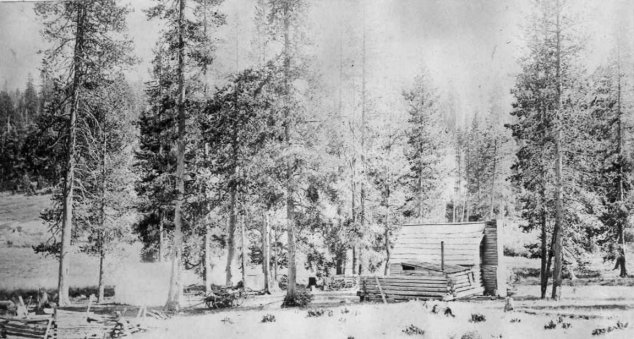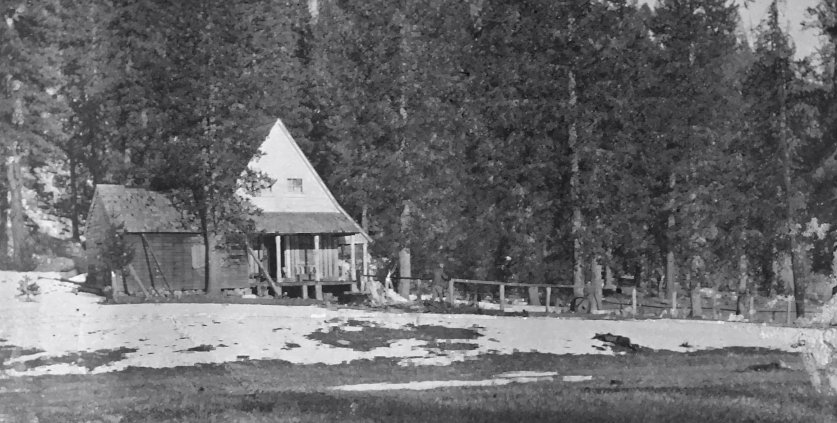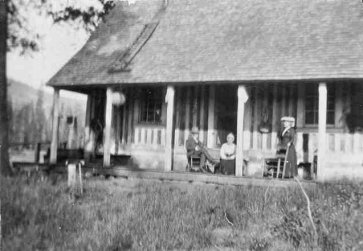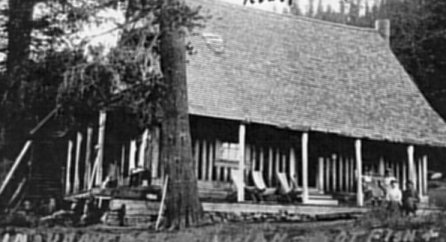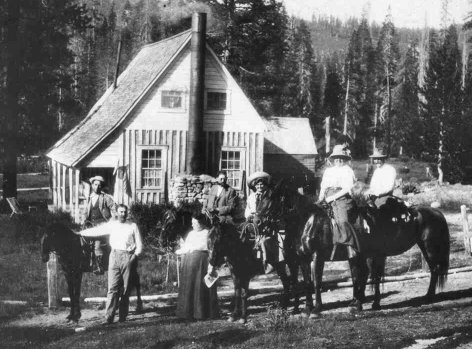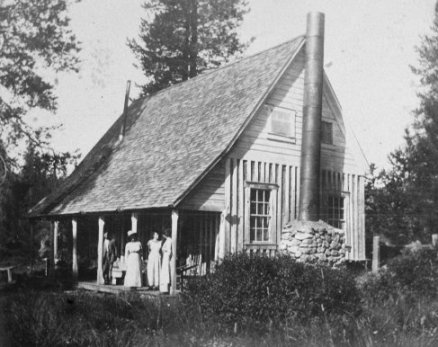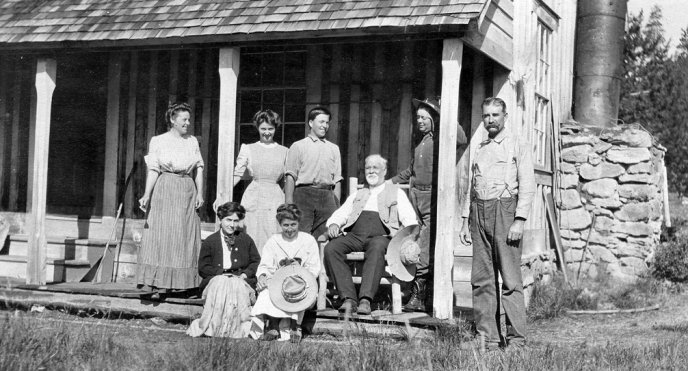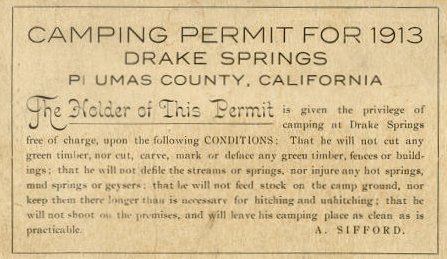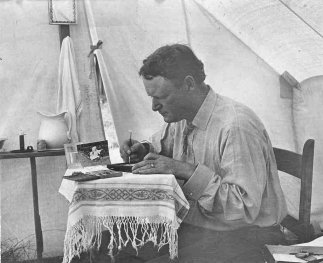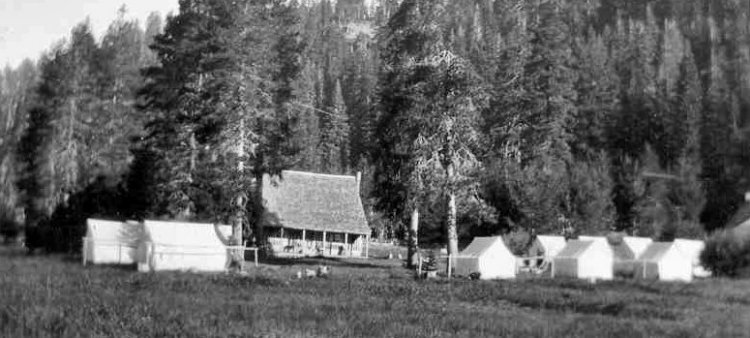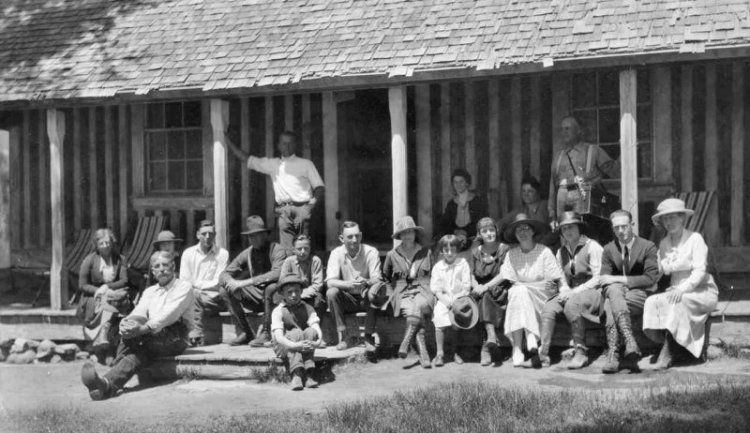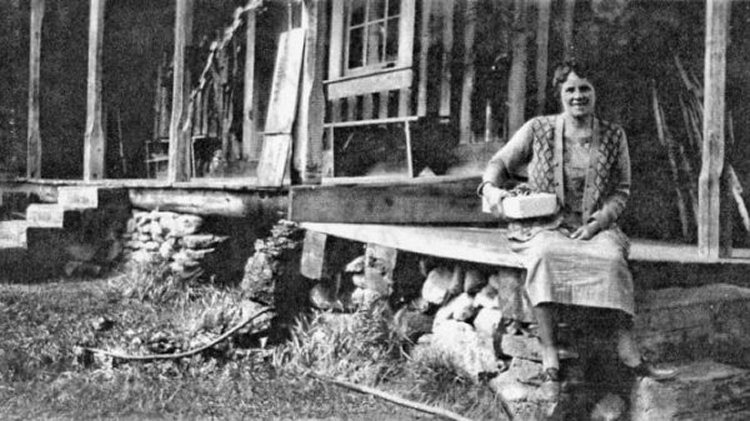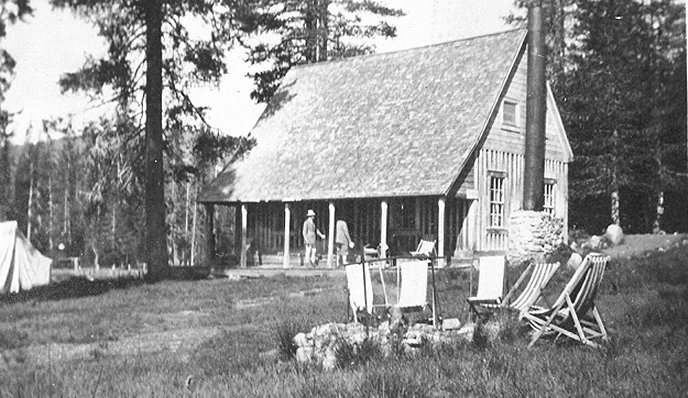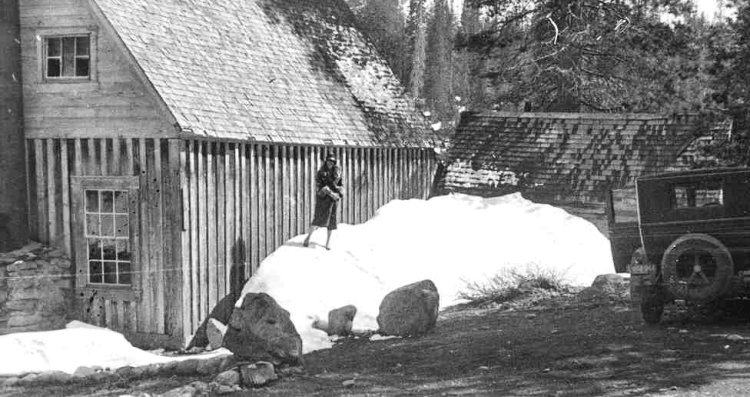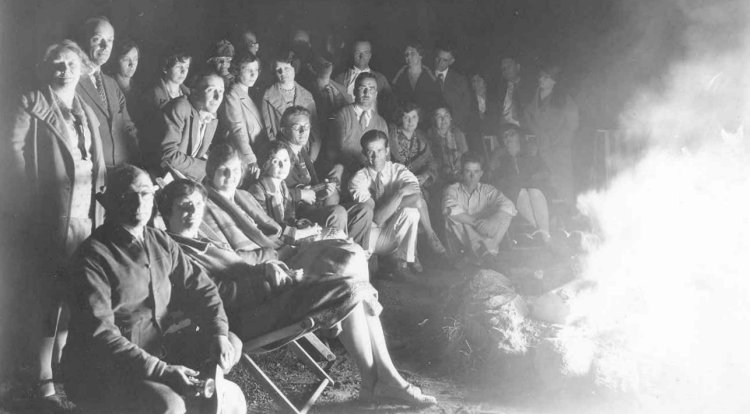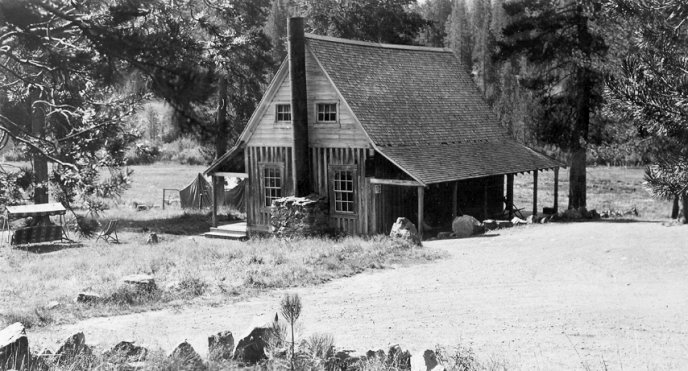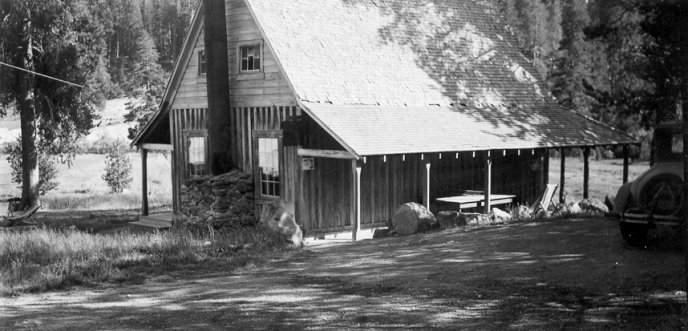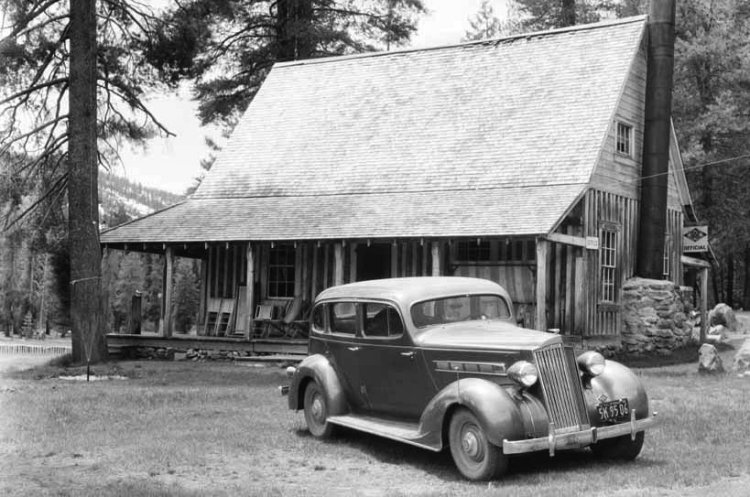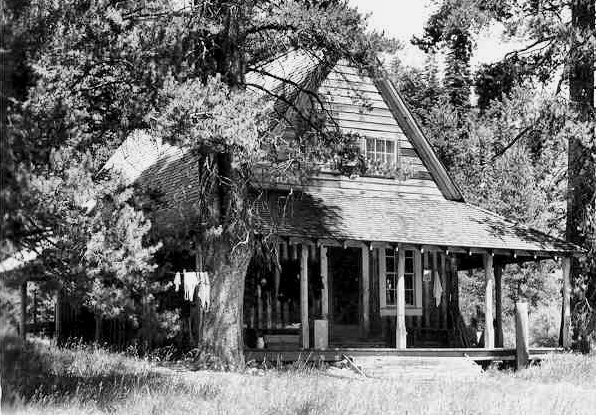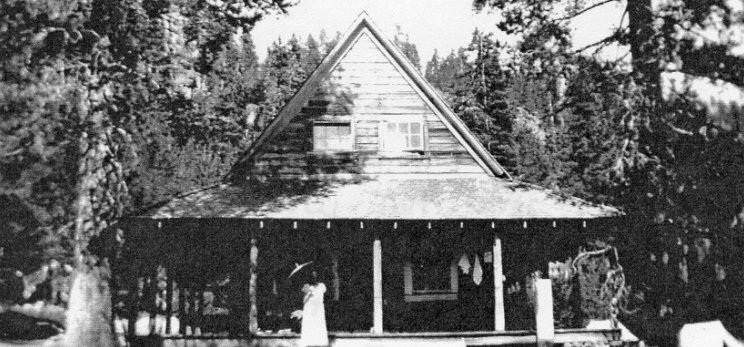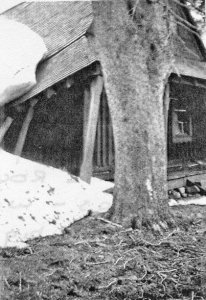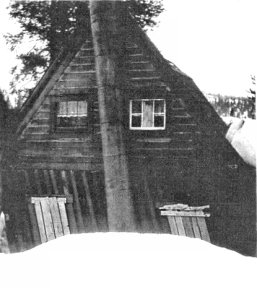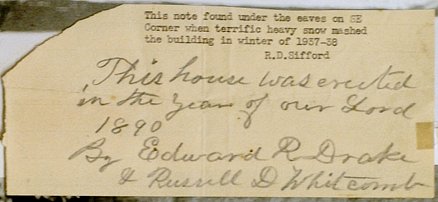Continuity and Change:
|
|
The First Lodge at Drakesbad Guest Ranch
Roy Sifford reports that "Drake had been there [Hot Spring Valley] since '87 had a log cabin, built a bath house and built a good, new log cabin of some size which was used for many years for the office and headquarters" (Roy Sifford interviewed by Les Bodine n.d.). Roy Sifford places the cabin shown above "near the site of the present lodge. To the right would be up valley [west] - to the left down valley [east]" (Sifford Manuscript:1).
On June the 20th, 1900, the Siffords' "took possession of Hot Spring Valley, the beautiful log house that Drake had made, the bath house, a barn and that possible meadow land" (Roy Sifford interviewed by Les Bodine, 9 Oct 1984). Both the lodge and the smaller structure on the left were built by Drake.
The lodge faced generally to the east and was fronted with a covered porch. There was another covered porch on the south end of the building, and a fireplace and flue at the north end. The west (rear) of the building was an unbroken wall without windows or doors and lacked a porch or overhang. Sifford states that the large pipe that served as the fireplace flue was part of a mining flume from the Dutch Hill mine at Seneca (Sifford Manuscript: 6a.). The south porch contained a bench and wash basins for family and guests to wash up before meals.
In 1912 the Siffords formed the Drakes Spring Company and used the funds obtained from investors to begin a number of improvements that included the construction of a kitchen and dining room, a barn, the rock and cement pool, 20 wooden tent platforms, and completion of the bridge over Warner Creek.
In 1914 the first telephone line was run from Chester to Drakesbad. On May 14, 1914, the Mount Lassen volcano came to life in the first of a series of eruptions. Two years later in 1916 Lassen Volcanic National Park was created.
In the photographs above taken in 1926 and 1927 the rear of the lodge lacks a covered porch. However the photographs taken in 1931 show that a covered porch has been added to the west side (rear) of the lodge. Also, the covered porch at the south end of the building appears to have been rebuilt at this time with its roof enlarged to connect with the porch roof on the east (front) side of the building, and with the new porch addition on the west (rear) side. Also, the small building adjacent to the southwest corner of the lodge and visible in several photographs dating from 1902 to 1927 disappears in photographs after 1931. It is likely that this building was removed to make room for the new porches. The lodge now had a covered porch extending around three sides of the building, the new sections constructed sometime between 1927 and 1931.
Roy Sifford returned to Drakesbad on May 10, 1938, to find that the lodge "had been smashed sideways" by the winter snows (Sifford 1994: 95). The damage to the lodge is visible in the two photographs above. The photo on the left shows the covered porch on the west and south sides of the building and the photograph on the right shows the north side (fireplace) of the lodge. Damage to the building was such that Roy Sifford considered the structure beyond repair. In addition to the damage to the lodge, Sifford reports that a store house and four cottages were "wrecked" (Roy Sifford interviewed by Dorothy Hill, June 8 1973). Why was the lodge, which had survived 46 previous winters intact, so severely damaged in the winter of 1937-38? Roy Sifford reports that the winter of 1937-38 was "the most severe that we had ever experienced". In December the Lassen area experienced a heavy snowfall of three to four feet, followed by what he describes as a "warm rain storm" which caused extensive flooding. January was another period of heavy snowfall, "more than 20 feet in depth in some places" (Sifford 1994: 93-94). Snowfall and snowpack data for the Northern Sierra confirm that the winter of 1937-38 was indeed as severe as Sifford reported. Data from Donner Summit shows that total snowfall in the northern Sierras that winter exceeded 700 inches, more snow than any winter since 1890 and far above the 415 inches in an average year. However, the recorded maximum snowpack depth for the year 1937-38 was only slightly more than 200 inches, likely due to melting during the period of warmer temperature mentioned by Sifford. The maximum snowpack depth for the year 1937-38, while deeper than the average of 137 inches,was equal to or less in depth than the snowpacks recorded for the years 1890, 1893, 1895, 1896, 1897, 1907, and 1911. If snowpack depth is a more accurate measure of the maximum weight of snow carried on the roof of the lodge at any particular time during the winter, then the winter of 1937-38 was severe, but not extraordinary. The lodge had withstood similar snow loads during six previous winters. This suggests that the addition of the new covered porch on the rear of the lodge and the enlargement of the covered porch on the south end may have contributed in some degree to the structural failure of the building. A rough analysis of the roof profile in the photographs indicates that the addition of the covered porch roof on the west (rear) side of the building increased the total snow-bearing roof area of the lodge by approximately 25 percent. Also, the photos of the rear of the lodge taken in 1927 and 1931 suggest that snow sloughing off the west porch roof at the rear of the lodge would not fall clear of the building but would build up in the narrow "valley" between the lodge and an earthen bank a few feet to the west. As the snow trapped in the narrow space between the lodge and earthen bank increased in depth it is probable that a considerable side force vector would press against the building. In addition to the factors discussed above, Roy Sifford was to discover that the construction methods employed by Edward Drake in 1890 were fundamentally flawed. When Sifford tore down the lodge in 1938 he discovered under the interior wallpaper what he considered to be inadequate sway bracing. The bracing for the hand hewn logs standing on end consisted "only of rough 1 x 12 boards nailed to the up right logs using No. 10 and 13 square nails, which allowed the building to be pushed sideways by the snow" (Sifford 1994: 98-100). During the process of removing the damaged building Roy Sifford discovered a note left by Edward Drake tucked away in the eaves of the building.
drakesbad/lodge.htm Last Updated: 09-Dec-2024 |
